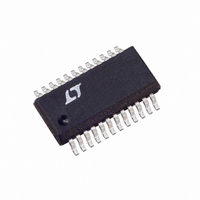LTC1755EGN#TR Linear Technology, LTC1755EGN#TR Datasheet - Page 8

LTC1755EGN#TR
Manufacturer Part Number
LTC1755EGN#TR
Description
IC SMART CARD INTERFACE 24SSOP
Manufacturer
Linear Technology
Datasheet
1.LTC1756EGNPBF.pdf
(16 pages)
Specifications of LTC1755EGN#TR
Applications
Smart Card
Voltage - Supply
2.7 V ~ 6 V
Package / Case
24-SSOP
Mounting Type
Surface Mount
Lead Free Status / RoHS Status
Contains lead / RoHS non-compliant
Interface
-
Available stocks
Company
Part Number
Manufacturer
Quantity
Price
LTC1755/LTC1756
PI FU CTIO S
microseconds then the LTC1755/LTC1756 switch to the
Alarm state. This fault checking is only performed after the
V
READY pin).
The clock channel is optimized for signal integrity in order
to meet the stringent duty cycle requirements of the EMV
specification. Therefore, to reduce power in low power
applications, clock stop mode is recommended when data
is not being exchanged.
CIN (Pins 13/9): (Input) Clock Input Pin from the Micro-
controller. During the Active state this signal appears on
the CLK pin after being level-shifted and buffered.
DV
RIN (Pins 14/10): (Input) Reset Input Pin from the Micro-
controller. During the Active state this signal appears on
the RST pin after being level-shifted and buffered.
DV
DATA (Pins 15/11): (Input/Output) Microcontroller Side
Data I/O Pin. This pin is used for bidirectional data transfer
between the microcontroller and the Smart Card. The
microcontroller data pin must be open drain and must be
able to sink up to 250 A when driving the DATA pin low
due to the pull-up current source. The DATA pin becomes
high impedance during the Idle state or when CS is high
(see the State Diagram). It does not become active until the
READY signal goes low indicating that V
AUX2IN (Pin 16, LTC1755 Only): (Input/Output) Micro-
controller Side Auxiliary I/O pin. This pin is used for
bidirectional auxiliary data transfer between the micro-
controller and the Smart Card. It has the same character-
istics as the DATA pin.
AUX1IN (Pin 17, LTC1755 Only): (Input/Output) Micro-
controller Side Auxiliary I/O Pin. This pin is used for
bidirectional auxiliary data transfer between the micro-
controller and the Smart Card. It has the same character-
istics as the DATA pin.
C
tor Terminals. Optimum values for the flying capacitor
range from 0.68 F to 1 F. Best performance is achieved
with a low ESR X7R ceramic capacitor.
8
CC
+
, C
CC
CC
U
pin has reached its final value (as indicated by the
–
sets the logic reference level for the C
sets the logic reference level for the R
(Pins 18/12, 19/13): Charge Pump Flying Capaci-
U
U
LTC1755/LTC1756
CC
is stable.
IN
IN
pin.
pin.
DV
Microcontroller Side Digital Input and Input/Output Pins
(Typically 3V). If the charge pump input pin (V
powered from the same source as the microcontroller,
then DV
only one (10 F) input bypass capacitor is needed for the
LTC1755. If the DV
should be bypassed separately with a 0.1 F capacitor. The
DV
The DV
drops below approximately 1.5V the LTC1755 automati-
cally enters the Idle state. On the LTC1756, DV
connected internally to V
READY (Pins 21/14): (Output) Readiness Indicator of the
Smart Card Supply Voltage (V
LTC1756 are placed in the Active state the soft-start
feature slowly ramps the V
pin indicates that V
The READY pin also indicates if the LTC1756 is in Alarm
mode. The LTC1756 detects faults such as V
for at least 5 s, overtemperature shutdown, CLK or RST
invalid output levels and card removal during Active
state. CLK or RST invalid and overtemperature faults are
detected only after V
underrange and card removal during Active faults are
detected at any time during the Active period (i.e., once
PWR = 0V).
If the LTC1756 has been activated normally and V
card voltage, has reached its final value then READY will
go low indicating normal operation. If, following this, a
fault occurs and the LTC1756 enters the Alarm state, the
READY pin will return high.
In the event that a fault precedes the activation of V
such as a direct short circuit from V
LTC1756 will attempt to operate until the fault is detected
and then automatically shut down and enter the Alarm
state. In this case the READY pin will never go low after the
command to start the smart card is given (i.e., PWR = 0V).
If the LTC1755/LTC1756 enter the Alarm state they can
only be cleared by returning the PWR pin high.
CC
CC
pin may be between 2V and 5.5V.
(Pin 20, LTC1755 Only): Supply Voltage for the
CC
CC
pin is monitored for adequate voltage. If DV
should be connected directly to V
CC
CC
CC
has reached its final value.
pin is powered separately then it
has reached its final value. V
IN
CC
.
voltage. A low on the READY
CC
). When the LTC1755/
CC
CC
IN
to GND, the
. In this case
underrange
CC
IN
CC
, the
) is
CC
CC
CC
is
,














